1999 TOYOTA CAMRY turn signal
[x] Cancel search: turn signalPage 4467 of 4592
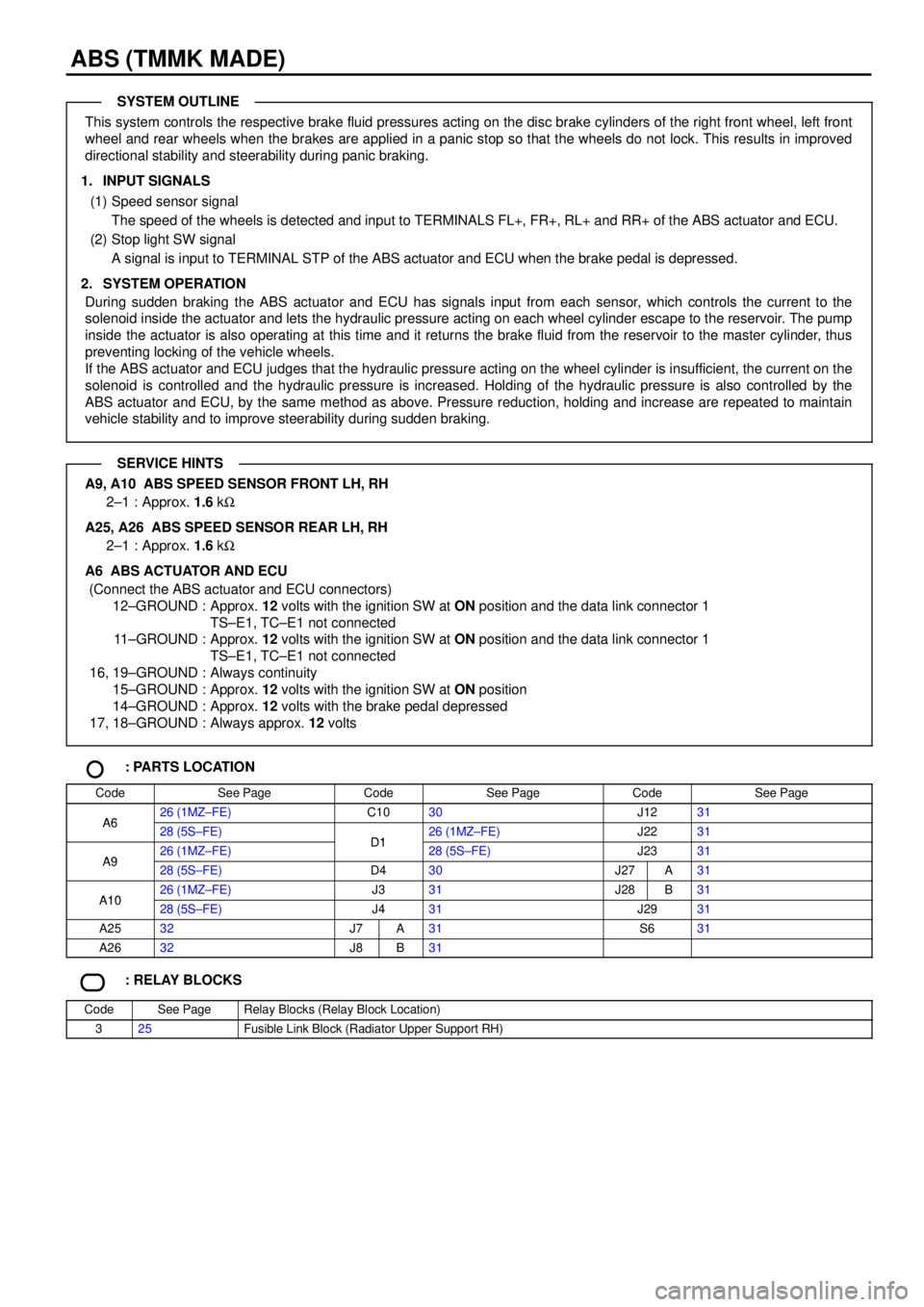
ABS (TMMK MADE)
This system controls the respective brake fluid pressures acting on the disc brake cylinders of the right front wheel, left front
wheel and rear wheels when the brakes are applied in a panic stop so that the wheels do not lock. This results in improved
directional stability and steerability during panic braking.
1. INPUT SIGNALS
(1) Speed sensor signal
The speed of the wheels is detected and input to TERMINALS FL+, FR+, RL+ and RR+ of the ABS actuator and ECU.
(2) Stop light SW signal
A signal is input to TERMINAL STP of the ABS actuator and ECU when the brake pedal is depressed.
2. SYSTEM OPERATION
During sudden braking the ABS actuator and ECU has signals input from each sensor, which controls the current to the
solenoid inside the actuator and lets the hydraulic pressure acting on each wheel cylinder escape to the reservoir. The pump
inside the actuator is also operating at this time and it returns the brake fluid from the reservoir to the master cylinder, thus
preventing locking of the vehicle wheels.
If the ABS actuator and ECU judges that the hydraulic pressure acting on the wheel cylinder is insufficient, the current on the
solenoid is controlled and the hydraulic pressure is increased. Holding of the hydraulic pressure is also controlled by the
ABS actuator and ECU, by the same method as above. Pressure reduction, holding and increase are repeated to maintain
vehicle stability and to improve steerability during sudden braking.
A9, A10 ABS SPEED SENSOR FRONT LH, RH
2±1 : Approx. 1.6 kW
A25, A26 ABS SPEED SENSOR REAR LH, RH
2±1 : Approx. 1.6 kW
A6 ABS ACTUATOR AND ECU
(Connect the ABS actuator and ECU connectors)
12±GROUND : Approx. 12 volts with the ignition SW at ON position and the data link connector 1
TS±E1, TC±E1 not connected
11±GROUND : Approx. 12 volts with the ignition SW at ON position and the data link connector 1
TS±E1, TC±E1 not connected
16, 19±GROUND : Always continuity
15±GROUND : Approx. 12 volts with the ignition SW at ON position
14±GROUND : Approx. 12 volts with the brake pedal depressed
17, 18±GROUND : Always approx. 12 volts
: PARTS LOCATION
CodeSee PageCodeSee PageCodeSee Page
A626 (1MZ±FE)C1030J1231A628 (5S±FE)D126 (1MZ±FE)J2231
A926 (1MZ±FE)D128 (5S±FE)J2331A928 (5S±FE)D430J27A31
A1026 (1MZ±FE)J331J28B31A1028 (5S±FE)J431J2931
A2532J7A31S631
A2632J8B31
: RELAY BLOCKS
CodeSee PageRelay Blocks (Relay Block Location)
325Fusible Link Block (Radiator Upper Support RH)
SYSTEM OUTLINE
SERVICE HINTS
Page 4478 of 4592
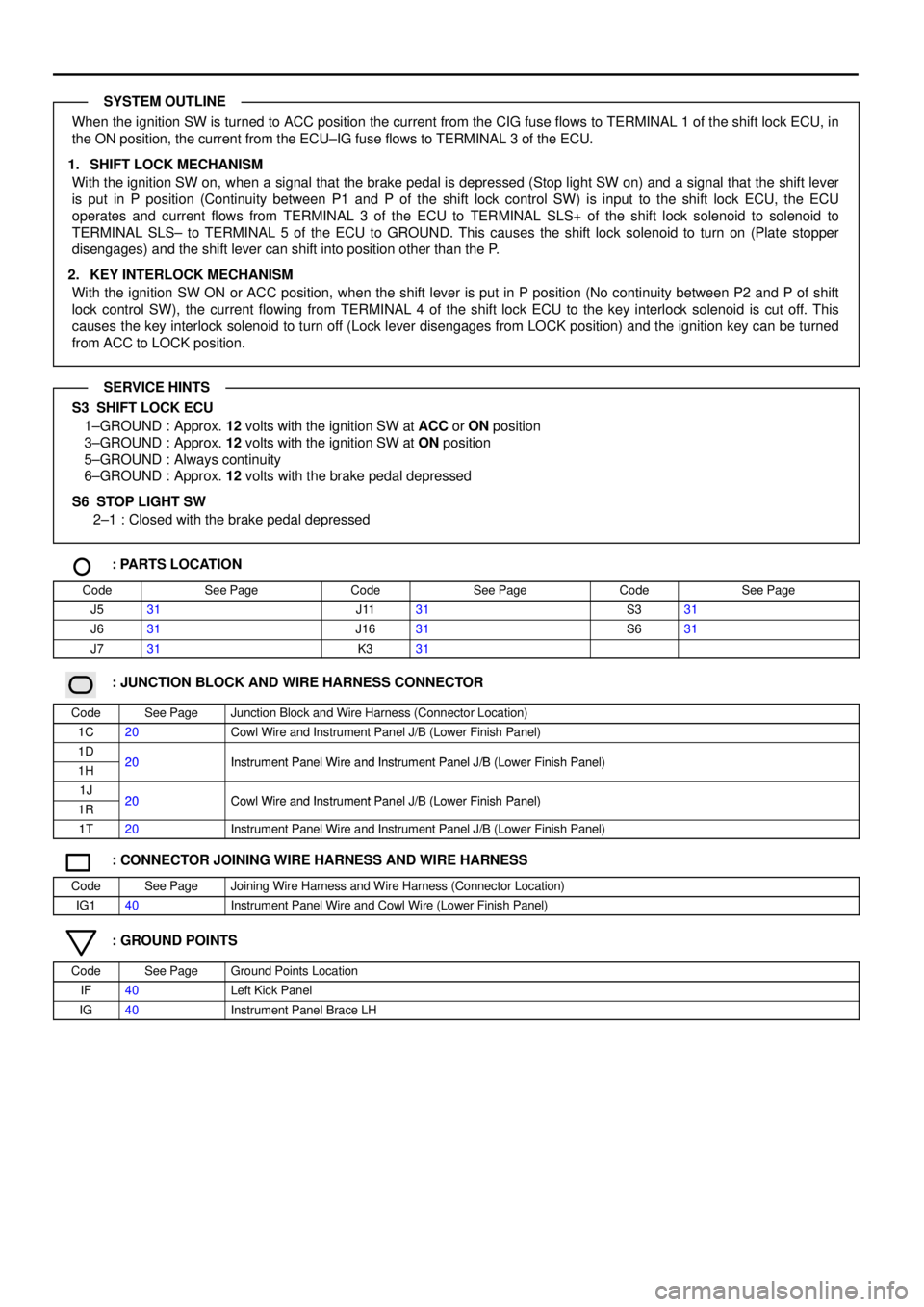
When the ignition SW is turned to ACC position the current from the CIG fuse flows to TERMINAL 1 of the shift lock ECU, in
the ON position, the current from the ECU±IG fuse flows to TERMINAL 3 of the ECU.
1. SHIFT LOCK MECHANISM
With the ignition SW on, when a signal that the brake pedal is depressed (Stop light SW on) and a signal that the shift lever
is put in P position (Continuity between P1 and P of the shift lock control SW) is input to the shift lock ECU, the ECU
operates and current flows from TERMINAL 3 of the ECU to TERMINAL SLS+ of the shift lock solenoid to solenoid to
TERMINAL SLS± to TERMINAL 5 of the ECU to GROUND. This causes the shift lock solenoid to turn on (Plate stopper
disengages) and the shift lever can shift into position other than the P.
2. KEY INTERLOCK MECHANISM
With the ignition SW ON or ACC position, when the shift lever is put in P position (No continuity between P2 and P of shift
lock control SW), the current flowing from TERMINAL 4 of the shift lock ECU to the key interlock solenoid is cut off. This
causes the key interlock solenoid to turn off (Lock lever disengages from LOCK position) and the ignition key can be turned
from ACC to LOCK position.
S3 SHIFT LOCK ECU
1±GROUND : Approx. 12 volts with the ignition SW at ACC or ON position
3±GROUND : Approx. 12 volts with the ignition SW at ON position
5±GROUND : Always continuity
6±GROUND : Approx. 12 volts with the brake pedal depressed
S6 STOP LIGHT SW
2±1 : Closed with the brake pedal depressed
: PARTS LOCATION
CodeSee PageCodeSee PageCodeSee Page
J531J1131S331
J631J1631S631
J731K331
: JUNCTION BLOCK AND WIRE HARNESS CONNECTOR
CodeSee PageJunction Block and Wire Harness (Connector Location)
1C20Cowl Wire and Instrument Panel J/B (Lower Finish Panel)
1D20Instrument Panel Wire and Instrument Panel J/B (Lower Finish Panel)1H20Instrument Panel Wire and Instrument Panel J/B (Lower Finish Panel)
1J20Cowl Wire and Instrument Panel J/B (Lower Finish Panel)1R20Cowl Wire and Instrument Panel J/B (Lower Finish Panel)
1T20Instrument Panel Wire and Instrument Panel J/B (Lower Finish Panel)
: CONNECTOR JOINING WIRE HARNESS AND WIRE HARNESS
CodeSee PageJoining Wire Harness and Wire Harness (Connector Location)
IG140Instrument Panel Wire and Cowl Wire (Lower Finish Panel)
: GROUND POINTS
CodeSee PageGround Points Location
IF40Left Kick Panel
IG40Instrument Panel Brace LH
SYSTEM OUTLINE
SERVICE HINTS
Page 4486 of 4592
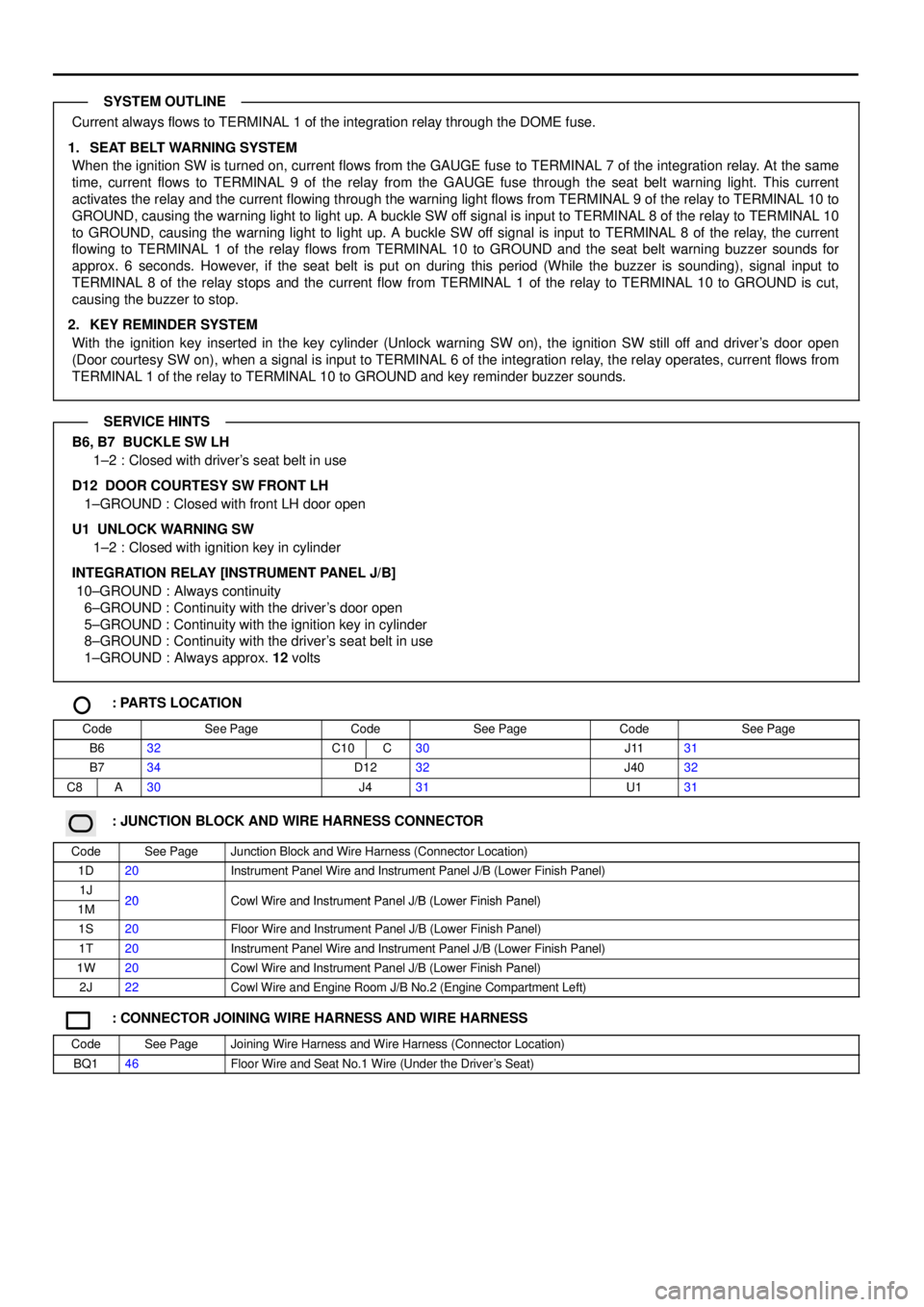
Current always flows to TERMINAL 1 of the integration relay through the DOME fuse.
1. SEAT BELT WARNING SYSTEM
When the ignition SW is turned on, current flows from the GAUGE fuse to TERMINAL 7 of the integration relay. At the same
time, current flows to TERMINAL 9 of the relay from the GAUGE fuse through the seat belt warning light. This current
activates the relay and the current flowing through the warning light flows from TERMINAL 9 of the relay to TERMINAL 10 to
GROUND, causing the warning light to light up. A buckle SW off signal is input to TERMINAL 8 of the relay to TERMINAL 10
to GROUND, causing the warning light to light up. A buckle SW off signal is input to TERMINAL 8 of the relay, the current
flowing to TERMINAL 1 of the relay flows from TERMINAL 10 to GROUND and the seat belt warning buzzer sounds for
approx. 6 seconds. However, if the seat belt is put on during this period (While the buzzer is sounding), signal input to
TERMINAL 8 of the relay stops and the current flow from TERMINAL 1 of the relay to TERMINAL 10 to GROUND is cut,
causing the buzzer to stop.
2. KEY REMINDER SYSTEM
With the ignition key inserted in the key cylinder (Unlock warning SW on), the ignition SW still off and driver's door open
(Door courtesy SW on), when a signal is input to TERMINAL 6 of the integration relay, the relay operates, current flows from
TERMINAL 1 of the relay to TERMINAL 10 to GROUND and key reminder buzzer sounds.
B6, B7 BUCKLE SW LH
1±2 : Closed with driver's seat belt in use
D12 DOOR COURTESY SW FRONT LH
1±GROUND : Closed with front LH door open
U1 UNLOCK WARNING SW
1±2 : Closed with ignition key in cylinder
INTEGRATION RELAY [INSTRUMENT PANEL J/B]
10±GROUND : Always continuity
6±GROUND : Continuity with the driver's door open
5±GROUND : Continuity with the ignition key in cylinder
8±GROUND : Continuity with the driver's seat belt in use
1±GROUND : Always approx. 12 volts
: PARTS LOCATION
CodeSee PageCodeSee PageCodeSee Page
B632C10C30J1131
B734D1232J4032
C8A30J431U131
: JUNCTION BLOCK AND WIRE HARNESS CONNECTOR
CodeSee PageJunction Block and Wire Harness (Connector Location)
1D20Instrument Panel Wire and Instrument Panel J/B (Lower Finish Panel)
1J20Cowl Wire and Instrument Panel J/B (Lower Finish Panel)1M20Cowl Wire and Instrument Panel J/B (Lower Finish Panel)
1S20Floor Wire and Instrument Panel J/B (Lower Finish Panel)
1T20Instrument Panel Wire and Instrument Panel J/B (Lower Finish Panel)
1W20Cowl Wire and Instrument Panel J/B (Lower Finish Panel)
2J22Cowl Wire and Engine Room J/B No.2 (Engine Compartment Left)
: CONNECTOR JOINING WIRE HARNESS AND WIRE HARNESS
CodeSee PageJoining Wire Harness and Wire Harness (Connector Location)
BQ146Floor Wire and Seat No.1 Wire (Under the Driver's Seat)
SYSTEM OUTLINE
SERVICE HINTS
Page 4507 of 4592
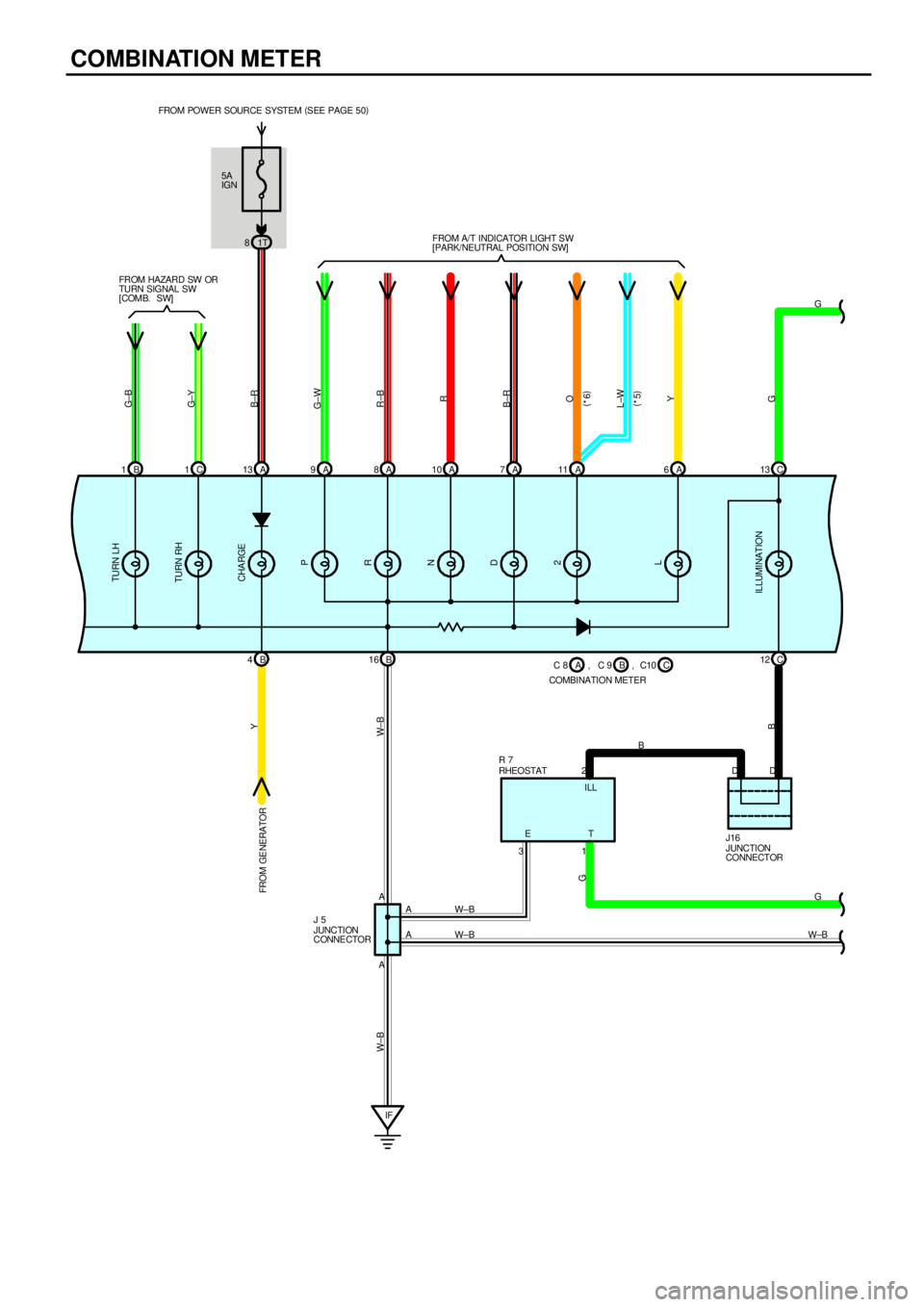
COMBINATION METER
5A
IGN
1T 8 FROM POWER SOURCE SYSTEM (
SEE PAGE 50)
B 1C1A13 A9A8A10 A7A6C13
B 4B16C 12
IFW±B
W±BG
W±BG
B
G±B
G±Y
B±R
G±W
R±B
R
B±R
O
Y
G Y
W± B W±B
G
B
A2DD
A31
A
AETILL FROM HAZARD SW OR
TURN SIGNAL SW
[COMB. SW]FROM A/T INDICATOR LIGHT S W
[PARK/NEUTRAL POSITION SW]FROM GE NERATORTURN LH
TURN RH
CHA RGE
P
R
N
D
2
L
ILLUMINATION
JUNCTION
CONNECTOR J16 RHEOSTAT R 7
JUNCTION
CONNE CTOR J 5C 8
COMBINATION METERB A, C 9 C, C10 A 11
L±W
(
*5) (
*6)
Page 4520 of 4592

1. HEATER BLOWER MOTOR OPERATION
Current is applied at all times through HTR fuse to TERMINAL 1 of the HTR relay. When the ignition SW is turned on,
current flows through the HEATER fuse to TERMINAL 5 of the HTR relay to TERMINAL 3 to TERMINAL HR of the A/C
control assembly. At the same time, current also flows from HEATER fuse to TERMINAL IG+ of the A/C control assembly.
*Low speed operation
When the blower SW (A/C control assembly) is pushed to LOW SPEED position, the current to TERMINAL HR of the
A/C control assembly flows to TERMINAL GND of the A/C control assembly to GROUND and turns the HTR relay on.
As a result, the current to TERMINAL 1 of the HTR relay flows to TERMINAL 2 of the relay to TERMINAL 2 of the
blower motor to TERMINAL 1 to TERMINAL 2 of the blower resistor to TERMINAL 6 to GROUND and causes the
blower motor to rotate at low speed.
*High speed operation
When the blower SW (A/C control assembly) is pushed to HIGH SPEED position, the current to TERMINAL HR of the
A/C control assembly flows to TERMINAL GND of the A/C control assembly to GROUND and turns the HTR relay on.
As a result, the current to TERMINAL 1 of the HTR relay flows to TERMINAL 2 to TERMINAL 2 of the blower motor to
TERMINAL 1 to TERMINAL 4 of the A/C blower motor linear controller to TERMINAL 2 to TERMINAL BLW of the A/C
control assembly (Which is activated when the blower SW is pushed to high speed position) to TERMINAL GND to
GROUND without passing through the blower resistor, causing the blower motor to rotate at high speed.
2. AIR INLET CONTROL SERVO MOTOR OPERATION
(Switching from FRESH to RECIRC)
With the ignition SW turned on, the current flows from HEATER fuse to TERMINAL IG+ of the A/C control assembly to
TERMINAL AIR to TERMINAL 7 of the air inlet control servo motor to TERMINAL 6 to TERMINAL AIF of the A/C control
assembly to TERMINAL GND to GROUND, the motor rotates and the damper moves to the RECIRC side. when the
damper operates with the A/C SW at RECIRC position, the damper position signal is input from TERMINAL 5 of the servo
motor to TERMINAL TPI of the A/C control assembly. As a result, current to the servo motor circuit is cut off by the A/C
control assembly, so the damper stops at that position.
(Switching from RECIRC to FRESH)
With the ignition SW turned on, when the RECIRC/FRESH SW is switched to the FRESH side, the current flows from
TERMINAL IG+ of the A/C control assembly to TERMINAL AIF to TERMINAL 6 of the air inlet control servo motor to
TERMINAL 7 to TERMINAL AIR of the A/C control assembly to TERMINAL GND to GROUND, The motor rotates and the
damper stops at that position.
3. AIR VENT MODE CONTROL SERVO MOTOR OPERATION
When the ignition SW turned on, the current flows from HEATER fuse to TERMINAL IG+ of the A/C control assembly.
(Switching from DEF to FACE)
The current flows from TERMINAL FACE of the A/C control assembly to TERMINAL 1 of the air vent mode control servo
motor to TERMINAL 5 to TERMINAL DEF of the A/C control assembly to TERMINAL GND to GROUND. The motor rotates
and the damper moves to the FACE side. When the damper operates with the A/C SW at FACE position, the damper
position signal is input from TERMINAL 5 of the servo motor to the TERMINAL DEF of the A/C control assembly. As a
result, current to the servo motor circuit is cut off by the A/C control assembly, so the damper stops at that position.
(Switching from FACE to DEF)
The current flows from TERMINAL DEF of the A/C control assembly to TERMINAL 5 of the air vent control servo motor to
TERMINAL 1 to TERMINAL FACE of the A/C control assembly to TERMINAL GND to GROUND, the motor rotates and the
damper stops at that position.
4. AIR MIX CONTROL SERVO MOTOR OPERATION
When the temperature control SW (A/C control assembly) is turned to the ºCOOLº side the current flows from TERMINAL
AMC of the A/C control assembly to TERMINAL 1 of the air mix control servo motor to motor to TERMINAL 2 to
TERMINAL AMH of the A/C control assembly to GROUND and the motor rotates. The damper opening angle at this time
is input from TERMINAL 3 of the servo motor to TERMINAL TP of the A/C control assembly, this is used to determine the
DAMPER STOP position and maintain the set temperature.
When the temperature control SW (A/C control assembly) is turned to the ºHOTº side, the current flows from servo motor
to TERMINAL AMH of the A/C control assembly to TERMINAL 2 of the air mix control servo motor to motor to TERMINAL
1 to TERMINAL AMC of the A/C control assembly, rotating the motor in reverse and switching the damper from ºCOOLº to
ºHOTº side.
SYSTEM OUTLINE
Page 4521 of 4592
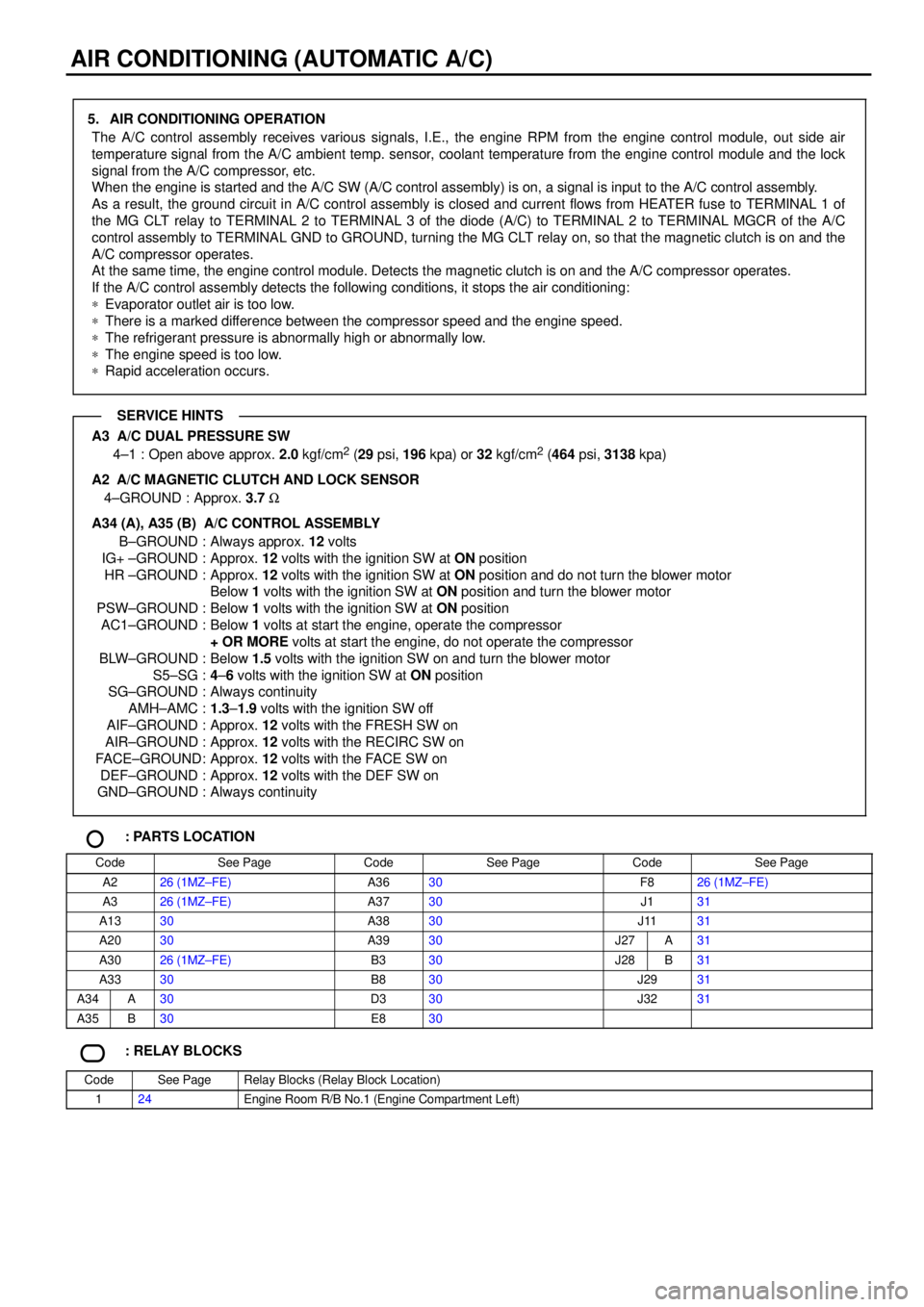
AIR CONDITIONING (AUTOMATIC A/C)
5. AIR CONDITIONING OPERATION
The A/C control assembly receives various signals, I.E., the engine RPM from the engine control module, out side air
temperature signal from the A/C ambient temp. sensor, coolant temperature from the engine control module and the lock
signal from the A/C compressor, etc.
When the engine is started and the A/C SW (A/C control assembly) is on, a signal is input to the A/C control assembly.
As a result, the ground circuit in A/C control assembly is closed and current flows from HEATER fuse to TERMINAL 1 of
the MG CLT relay to TERMINAL 2 to TERMINAL 3 of the diode (A/C) to TERMINAL 2 to TERMINAL MGCR of the A/C
control assembly to TERMINAL GND to GROUND, turning the MG CLT relay on, so that the magnetic clutch is on and the
A/C compressor operates.
At the same time, the engine control module. Detects the magnetic clutch is on and the A/C compressor operates.
If the A/C control assembly detects the following conditions, it stops the air conditioning:
*Evaporator outlet air is too low.
*There is a marked difference between the compressor speed and the engine speed.
*The refrigerant pressure is abnormally high or abnormally low.
*The engine speed is too low.
*Rapid acceleration occurs.
A3 A/C DUAL PRESSURE SW
4±1 : Open above approx. 2.0 kgf/cm2 (29 psi, 196 kpa) or 32 kgf/cm2 (464 psi, 3138 kpa)
A2
A/C MAGNETIC CLUTCH AND LOCK SENSOR
4±GROUND : Approx. 3.7 W
A34 (A), A35 (B) A/C CONTROL ASSEMBLY
B±GROUND : Always approx. 12 volts
IG+ ±GROUND : Approx. 12 volts with the ignition SW at ON position
HR ±GROUND : Approx. 12 volts with the ignition SW at ON position and do not turn the blower motor
Below 1 volts with the ignition SW at ON position and turn the blower motor
PSW±GROUND : Below 1 volts with the ignition SW at ON position
AC1±GROUND : Below 1 volts at start the engine, operate the compressor
+ OR MORE volts at start the engine, do not operate the compressor
BLW±GROUND : Below 1.5 volts with the ignition SW on and turn the blower motor
S5±SG :4±6 volts with the ignition SW at ON position
SG±GROUND : Always continuity
AMH±AMC :1.3±1.9 volts with the ignition SW off
AIF±GROUND : Approx. 12 volts with the FRESH SW on
AIR±GROUND : Approx. 12 volts with the RECIRC SW on
FACE±GROUND: Approx. 12 volts with the FACE SW on
DEF±GROUND : Approx. 12 volts with the DEF SW on
GND±GROUND : Always continuity
: PARTS LOCATION
CodeSee PageCodeSee PageCodeSee Page
A226 (1MZ±FE)A3630F826 (1MZ±FE)
A326 (1MZ±FE)A3730J131
A1330A3830J1131
A2030A3930J27A31
A3026 (1MZ±FE)B330J28B31
A3330B830J2931
A34A30D330J3231
A35B30E830
: RELAY BLOCKS
CodeSee PageRelay Blocks (Relay Block Location)
124Engine Room R/B No.1 (Engine Compartment Left)
SERVICE HINTS
Page 4528 of 4592

Current always flows from the HTR fuse to TERMINAL 1 of the HTR relay. When the ignition SW is turned on, the current
from the HEATER fuse flows to TERMINAL 6 of the air vent mode control servo motor, to the MG CLT relay (Coil side) to
TERMINAL MGC of the A/C amplifier (1MZ±FE) or TERMINAL MGC of the engine control module (5S±FE), to TERMINAL 1
of the A/C dual pressure SW to TERMINAL 4 to TERMINAL +B of the A/C amplifier (1MZ±FE) or TERMINAL PRS of the
engine control module (5S±FE), current also to the HTR relay (Coil side) to TERMINAL 3 of the blower SW.
1. AIR VENT MODE CONTROL SERVO MOTOR OPERATION
When the damper is in FACE position and B/L mode on the heater control SW is selected, current flows from TERMINAL 7
of the heater control SW to TERMINAL 2 of the air vent mode control serve motor so that a signal that the ground circuit is
activated is input into TERMINAL B of the control circuit inside the air vent mode control servo motor. Simultaneously, a
signal that the ground circuit is not activated is input into TERMINAL A of the control circuit inside the servo motor. These two
signals activate the control circuit so that current flows from the HEATER fuse to the servo motor, causing the servo motor to
operate and the damper to move to B/L position. When the damper reaches B/L position. A ground cut signal is input into
TERMINAL B of the control circuit, the control circuit operates, the servo motor stops rotating and the damper stops at B/L.
When another mode position is selected, input of signals into TERMINAL A and TERMINAL B of the control circuit that
ground is made or not (as explained above) activates the control circuit and moves the serve motor to the desired position.
2. AIR CONDITIONING OPERATION
When the blower SW is on, current flows from the HEATER fuse to the HTR relay (Coil side) to TERMINAL 3 of the blower
SW to TERMINAL 1 to GROUND, activating the HTR relay. This causes current to flow from the HTR fuse to the HTR relay
(Point side) to A/C fuse to TERMINAL 2 of the A/C SW. If the A/C SW is turned on at this time, a signal is input into the A/C
amplifier (1MZ±FE) or engine control module (5S±FE). This activates the A/C amplifier (1MZ±FE) or engine control module
(5S±FE) and MG CLT relay so that current flows from the HEATER fuse to the MG CLT relay (Point side) to A/C magnetic
clutch. Causing The compressor to operate.
When blower SW is on and heater control SW is at DEF position, it causes A/C to run whether A/C SW is on or not.
HTR RELAY [R/B NO.1]
1±2 : Closed with the ignition SW on and the blower SW on
MG CLT RELAY [R/B NO.1]
5±3 : Closed with the ignition SW on, the blower SW on and the A/C SW on or the heater control SW at DEF position
A3 A/C DUAL PRESSURE SW
1±4 : Open with pressure 2.0 kgf/cm
2 (29 psi, 196 kpa) or above 32 kgf/cm2 (464 psi, 3138 kpa)
B4
BLOWER RESISTOR
6±1 : Approx. 0.62 W
1±3 : Approx. 1.46 W
2±6 : Approx. 0.38 W
: PARTS LOCATION
CodeSee PageCodeSee PageCodeSee Page
A226 (1MZ±FE)B430J831A228 (5S±FE)B530J1131
A326 (1MZ±FE)D326 (1MZ±FE)J1231A328 (5S±FE)E7A30J2331
A1230E8B30J27A31
A1330E9C30J28B31
A1430F826 (1MZ±FE)J2931
A2030F828 (5S±FE)J3231
B330H930
: RELAY BLOCKS
CodeSee PageRelay Blocks (Relay Block Location)
124Engine Room R/B No.1 (Engine Compartment Left)
SYSTEM OUTLINE
SERVICE HINTS
Page 4531 of 4592
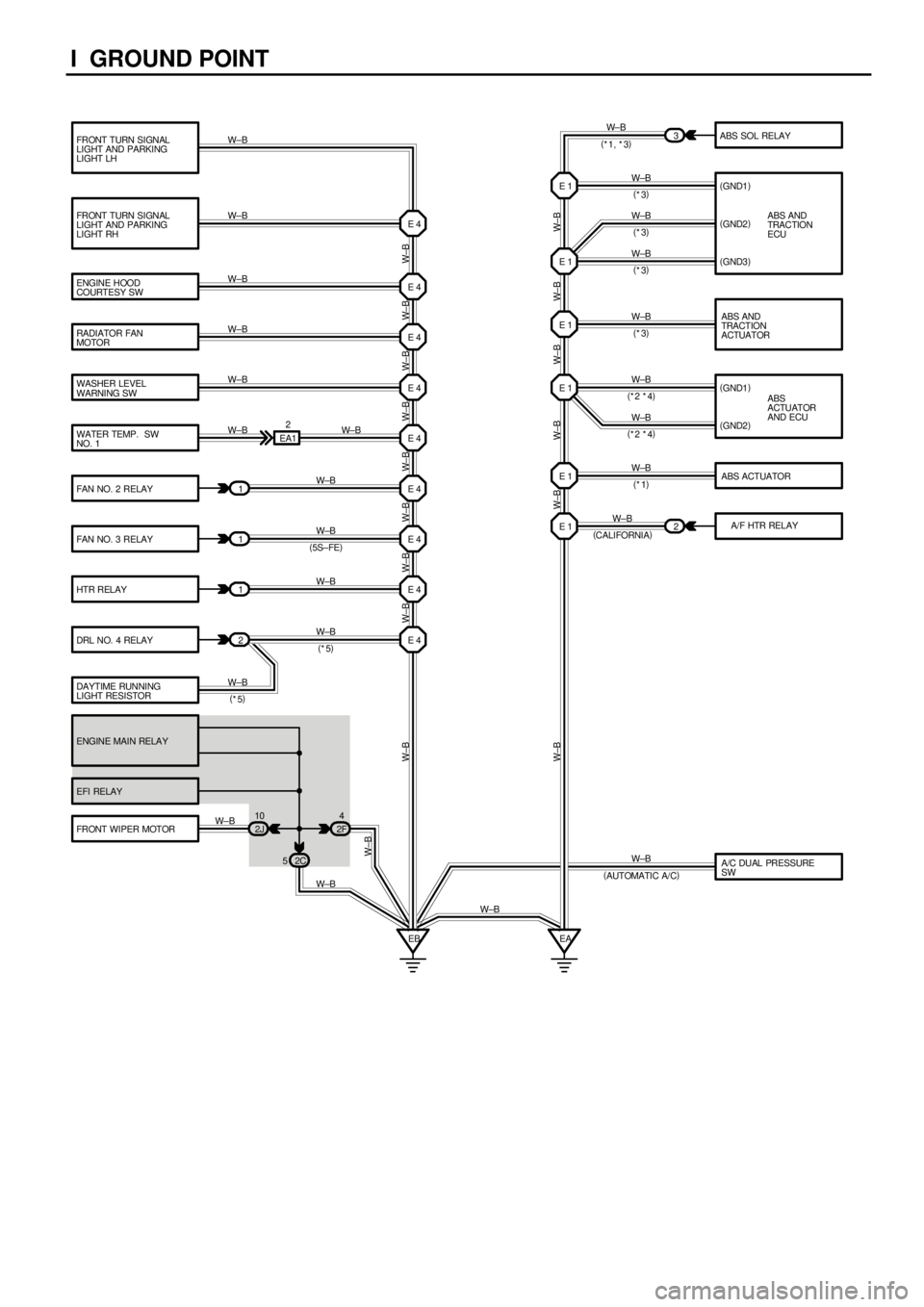
I GROUND POINT
FRONT TURN SIGNAL
LIGHT AND PARKING
LIGHT LH
FRONT TURN SIGNAL
LIGHT AND PARKING
LIGHT RH
ENGINE HOOD
COURTESY SW
RADIATOR FAN
MOTOR
WASHER LEVEL
WARNING SW
WATER TEMP. SW
NO. 1
FAN NO. 2 RELAYABS SOL RELAY
ABS AND
TRACTION
ECU (
GND2)
(
GND3)
(
GND1)
(
GND2)
FAN NO. 3 RELAY
HTR RELAY
DRL NO. 4 RELAY
ENGINE MAIN RELAY
EFI RELAY
FRONT WIPER MOTOR(
GND1)
ABS AND
TRACTION
ACTUATOR
ABS
ACTUATOR
AND ECU
ABS ACTUATOR
1
1
1
2EA12
E 4 E 4
E 4
E 4
E 4
E 4
E 4
E 4
E 4
2J 10
2F4
2C 5
EB3
E 1
E 1
E 1
E 1
E 1
EA W±B W±B W±B
W±B W±B W±B
W± B
W±B
W±B
W±B
W±BW±B
W±B
W±B
W±B
W±B
W±B
W±B
W±B W± B W±B W±B W± B W±B W±B W±B W±B
W±B
W± B W± B W±B W±B W±B
W± B
(
5S±FE)(
*1, *3)
(
*3)
(
*3)
(
*3)
(
*3)
(
*2 *4)
(
*2 *4)
(
*1)
(
*5)
W±B
W±B DAYTIME RUNNING
LIGHT RESISTORW±B
(
*5)
W±BE 1 2W±B
(
CALIFORNIA)A/F HTR RELAY
W±B
A/C DUAL PRESSURE
SW W±B
(
AUTOMATIC A/C)